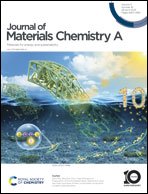Predicting the Na+ ion transport properties of NaSICON materials using density functional theory and Kinetic Monte Carlo†
Abstract
The efficiency of all-solid-state Na+ ion batteries crucially depends on the applied electrolyte, among which sodium super ionic conductors (NaSICONs) show high ionic conductivities. However, the experimental data on ionic conductivities available in the literature vary by several orders of magnitude depending on composition and sample preparation. Hence, a comprehensive understanding of Na+ transport properties is still lacking. In this study, we investigate the multi-cationic NaSICONs Na1+xM2SixP3−xO12 (with M = Zr4+, Hf4+, Sn4+, and 0 ≤ x ≤ 3) by combining state-of-the-art computational tools, namely density functional theory calculations to analyse the structure at the atomic level and Kinetic Monte Carlo simulations to study the ion transport on the macroscopic level. The results show that there is no simple correlation between structural properties and the Na+ ion transport as often described in the literature. Rather the interplay of the ratio of unoccupied to occupied charge carrier sites, interactions between Na+ ions and adjacent cations, and Na+ migration barriers, which are influenced by both the M-cation and the degree of substitution, must be considered. Our study provides a detailed picture of the complex ion transport in NaSICONs of variable composition.

- This article is part of the themed collection: Celebrating International Women’s day 2024: Women in Materials Science


 Please wait while we load your content...
Please wait while we load your content...